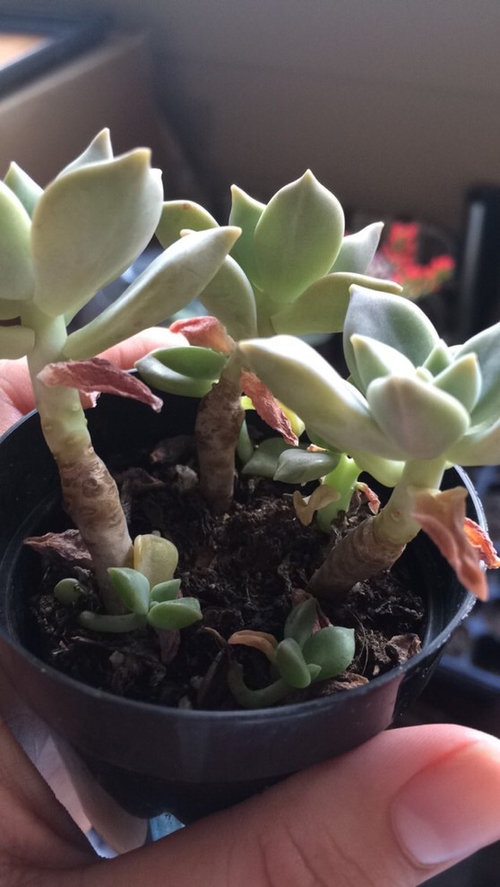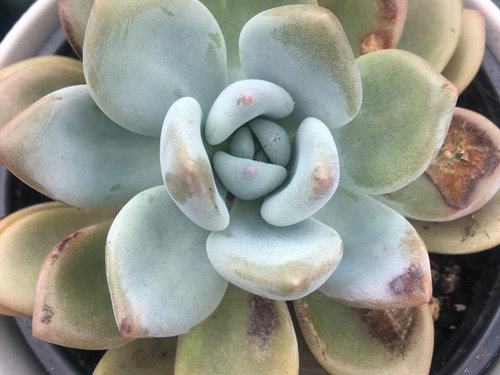When there isn’t enough direct sunlight, ghost plant leaves either fall off or self-propagate by taking root and growing another ghost plant. Stress brought on by excessive watering and poorly draining soils can also cause ghost plant leaves to fall off.
Without adequate light, ghost plants (Graptopetalum paraguayense) produce a long stalk from which the lower leaves fall off while the rosette stays attached in search of more direct light.
Continue reading to find out the cause of your ghost plant losing leaves and how to fix it.
Table of Contents
Not Enough Light Causes Ghost Plants Lower Leaves to Fall off
The most frequent cause of a ghost plant losing its bottom leaves is a lack of sufficient direct light.
Ghost plants are succulents that have evolved specifically to flourish in warm temperatures, full light, and sandy or stony soils.
When there is insufficient light, the ghost plant’s stalk can get tall (or possibly long enough to hang down from pots) (etiolate).
Long, gangly stems with few leaves result from the taller stems’ tendency to develop in the direction of the most light.
The lovely rosette typically remains unaltered, but the lower stem leaves have a tendency to fall off, leaving a long stem devoid of foliage.
In an effort to conserve resources, the ghost plant loses the leaves that are lower on the stalk and receive less light in favor of retaining the rosette.
This does not necessarily imply that your plant is dying; it could just suggest that it is experiencing more stress due to a lack of direct light.
A ghost plant needs to be in full light in order to grow compactly. This entails placing the succulent either outside or in a bright, south-facing window.
Typically, indirect bright light is insufficient for succulents like the ghost plant to maintain their attractive compact shape.
Your ghost plant can still be restored even if it has completely lost all of its lower leaves, leaving only a long stem and a rosette.
The best choice is to divide the ghost plant from a leaf of the rosette to produce a new plant that doesn’t have a long, unattractive stem, or to clip the rosette off with a pair of sterile pruners so that it can be divided in a pot and grow more compactly (assuming its in full sun).
If you have long, bare stems, give it a try and you can have many more ghost plants because they are quite successful to reproduce and it is very satisfying to watch them grow.
In order to revive ghost plants that have grown with long stems and few leaves, watch this instructive YouTube video, which demonstrates how to propagate and prune them precisely:
Ghost Plants Grow Quickly Causing Leaves to Drop off
As previously mentioned, ghost plants respond to a lack of direct sunlight by becoming leggy and losing their leaves, but even in bright sunlight, they often grow more quickly than other succulents, giving them a lanky appearance over time. Leaf loss may also follow from this.
In that situation, the same advice that applies when ghost plants become tall and lose their lower leaves due to a lack of sunlight is to expect this plant to require some routine maintenance.
So to maintain proportion and order as it develops over time, periodically prune your ghost plant back and propagate the rosette.
You may instantly rebuild your potted arrangement to meet your needs because ghost plants often reproduce.
Ghost plants Naturally Lose Leaves to Self Propagate
In the realm of succulents, ghost plants are particularly renowned for their ability to quickly grow new plants by dropping parts of their leaves.
As a result, ghost plants occasionally do lose their leaves on their own, without being stressed by a lack of sunlight, rapid growth, or excessive watering.
If left to their own devices, fallen leaves that remain on the soil develop a callus over their wounds (to retain moisture) and begin a completely new plant.
They do this because it is one of the strategies they employ in their natural habitat to increase the number of plants.
The ghost plant leaf that has fallen can develop roots if it is in a container with exposed soil (and enough room to grow), and before you know it, you will have a pot of little ghost plants.
You can either transplant these plants to another pot or let them grow into full-sized ghost plants.
While many succulents drop their leaves in order to reproduce themselves, ghost plants exhibit this effect most strongly and successfully.
Over watering or Slow Draining Soils can Cause Ghost Plant to Lose Leaves
In fact, ghost plants have evolved expressly to survive in this environment and need it for them to flourish.
Their optimal circumstances are not overwatering or poorly draining soils.
Too much moisture stresses out a plant, which results in drooping leaves and, in extreme circumstances, stem and root rot that can kill your ghost plant.
Native to extremely arid and hot regions of Mexico, ghost plants benefit from being dormant in the summer to conserve resources and increase growth in the cooler months of the year.
Due to this seasonal cycle, ghost plants in particular are more vulnerable to stress from over watering in the summer, which can cause leaves to fall off and the health of the plant to deteriorate.
Depending on how severely the stress brought on by too much moisture around the roots manifests itself, overwatered ghost plant leaves may feel soft, turn yellow, and eventually fall off.
On order to recreate the native range of the ghost plant, it is crucial to prioritize good watering techniques and grow your ghost plants in well-draining soil that has been improved with grit.
Your ghost plant needs little care and should be strong enough to avoid losing leaves due to stress if you follow the recommended watering schedule and use well-draining soil.
Key Takeaways:
- In order to reproduce themselves or in response to a lack of direct sunlight, ghost plants shed their leaves.
- The ghost plant, which thrives in dryer circumstances, is stressed by overwatering and slow-draining soils, which results in some of the leaves falling off.
- Ghost plants can have long stems with few leaves since they develop more quickly than the majority of succulents.
- To replenish a scarce ghost plant, propagate it from cuttings and from leaves.
FAQ
How much sun does a ghost plant need?
between 4 and 6 hours
Will succulent leaves grow back if they fall off?
Are you unsure if the leaves your succulent lost will ever grow back? The quick answer is that leaves won’t regrow on the stem from which they fell. But it’s not always a bad thing. New leaves will sprout from the top of your succulent.
Why are my succulent leaves dropping off?
Most succulents like extremely hot, dry environments to grow. Sometimes a plant’s natural defense against prolonged periods of extreme heat or drought is to shed its leaves. Even if managing with fallen leaves is a common strategy, you don’t want it in a lovely decorative plant.
Can you save a succulent with no leaves?
Few alternatives COULD rescue your succulent if it is only dropping leaves. Allow the soil to totally dry before giving it further time before watering. Remove the succulent from the soil and any dirt adhering to the roots if you have already done this and the plant is still shedding leaves.
How do you save a ghost plant?
When your ghost plant produces numerous, long stems with little to no leaves, it is typically an indication that it is not getting enough sunshine. Place the plant in a spot that receives four to six hours each day of direct sunlight and plenty of bright light.



